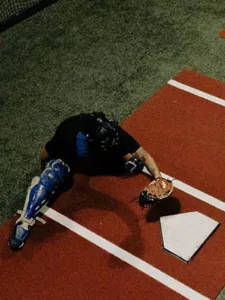 Sub 2.0 Catcher Pop Time in baseball is a unique stat that requires a blend of agility, strength, precision, and mental acuity. Among the various skills a catcher must master, pop time stands out as one of the most crucial. It is a direct measure of a catcher's ability to control the game by preventing stolen bases.
Sub 2.0 Catcher Pop Time in baseball is a unique stat that requires a blend of agility, strength, precision, and mental acuity. Among the various skills a catcher must master, pop time stands out as one of the most crucial. It is a direct measure of a catcher's ability to control the game by preventing stolen bases.
What is Pop Time?
Pop time is the measure of how quickly a catcher can transfer the ball from the mitt to the throwing hand and release it to second base. Specifically, it starts from the moment the pitch hits the catcher’s mitt and ends when the throw reaches the infielder’s glove at second base. This metric is critical in determining a catcher's effectiveness in throwing out base stealers. A pop time of under 2.0 seconds is considered elite and is a benchmark for high-level performance in this position.
Importance of Sub 2.0 Pop Time
Achieving a sub 2.0 pop time is not just a mark of speed; it encompasses a catcher's overall defensive prowess. A quick pop time can deter opposing teams from attempting to steal bases, effectively shutting down a key aspect of their offensive strategy. This capability enhances the catcher’s value to their team, as they contribute significantly to maintaining control over the game. A sub 2.0 pop time reflects not only superior athleticism but also refined technique and mental sharpness, making it a highly sought-after skill in professional baseball.
Brief History and Evolution of Catcher Pop Time
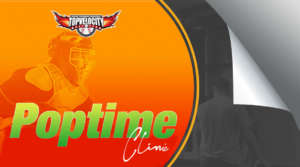 The concept of pop time has evolved significantly over the years. Historically, catchers relied primarily on natural talent and raw athleticism to control the game. Early training methods were rudimentary, focusing more on general fitness and less on specialized skills. As the game of baseball evolved, so did the understanding of the importance of pop time.
The concept of pop time has evolved significantly over the years. Historically, catchers relied primarily on natural talent and raw athleticism to control the game. Early training methods were rudimentary, focusing more on general fitness and less on specialized skills. As the game of baseball evolved, so did the understanding of the importance of pop time.
Advancements in technology and biomechanics have revolutionized how catchers train and refine their skills. Today, there is a scientific approach to improving pop time, involving detailed analysis of biomechanics, strength and conditioning programs tailored specifically for catchers, and the use of high-speed cameras to capture and analyze every aspect of the catch-and-throw process.
The evolution of pop time has also been influenced by changes in the game itself. As base stealing became a more prominent offensive strategy, the need for quicker, more efficient catchers increased. This led to more focused training regimes and the development of drills and exercises specifically designed to enhance pop time.
Technical Specifications: Sub 2.0 Catcher Pop Time
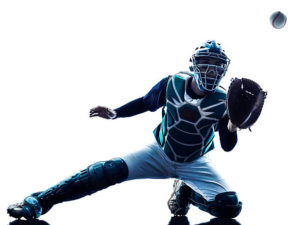
Understanding the technical specifications involved in measuring and improving pop time is crucial for catchers and coaches aiming to refine this skill. The technical aspects include the methods of measurement, the equipment used, and the key metrics that provide insight into a catcher’s performance.
Measuring Pop Time: Sub 2.0 Catcher Pop Time
Pop time is typically measured from the moment the pitch hits the catcher’s mitt to the moment the ball reaches the infielder’s glove at second base. This measurement can be done using several methods, ranging from manual timing with a stopwatch to more advanced techniques involving high-speed cameras and motion capture technology.
- Manual Timing: The simplest method involves using a stopwatch. While this method can provide a rough estimate, it is often subject to human error and reaction time delays.
- High-Speed Cameras: These provide more accurate measurements by capturing the entire motion in high detail. The footage can be analyzed frame by frame to determine the exact time the ball leaves the glove and reaches the infielder’s glove.
- Motion Capture Technology: Advanced systems use sensors and motion capture to track the ball and the catcher’s movements. This technology provides precise data and can analyze various aspects of the throw, including speed, trajectory, and biomechanics.
Equipment Needed for Accurate Measurement: Sub 2.0 Catcher Pop Time
 Accurate measurement of pop time requires specific equipment designed to capture and analyze the fast-paced action involved in catching and throwing.
Accurate measurement of pop time requires specific equipment designed to capture and analyze the fast-paced action involved in catching and throwing.
- High-Speed Cameras: Essential for capturing detailed footage of the catcher’s movements. These cameras can record at thousands of frames per second, allowing for precise analysis of each stage of the throw.
- Radar Guns: Used to measure the speed of the throw. Knowing the velocity of the throw helps in understanding the efficiency and power behind the catcher’s technique.
- Stopwatches: While not as accurate as high-speed cameras, stopwatches are still used for quick assessments and training purposes.
- Motion Capture Systems: These systems use sensors placed on the catcher’s body to track and analyze movements in real-time. They provide comprehensive data on biomechanics, which is crucial for fine-tuning technique.
- Analysis Software: Specialized software is used to analyze the data captured by high-speed cameras and motion capture systems. This software can provide detailed feedback on various metrics, helping catchers and coaches identify areas for improvement.
Key Metrics for Evaluation: Sub 2.0 Catcher Pop Time
Several key metrics are used to evaluate and improve pop time. These metrics provide a comprehensive view of a catcher’s performance and help in identifying specific areas that need attention.
- Reaction Time: The time it takes for the catcher to react to the pitch and begin the transfer process. Faster reaction times contribute significantly to reducing overall pop time.
- Transfer Speed: The speed at which the catcher moves the ball from the glove to the throwing hand. Efficient transfer mechanics are crucial for a quick pop time.
- Throwing Velocity: The speed of the throw from the catcher to the infielder. Higher throwing velocity can compensate for slightly slower reaction or transfer times, but it must be balanced with accuracy.
- Footwork Efficiency: The efficiency and quickness of the catcher’s foot movements during the transfer and throw. Proper footwork helps generate power and accuracy in the throw.
- Throwing Accuracy: The precision with which the catcher can deliver the ball to the infielder. Accurate throws are essential for successfully throwing out base stealers.
- Biomechanical Efficiency: This involves analyzing the catcher’s movements to ensure they are using their body in the most efficient way possible. It includes factors like hip rotation, shoulder alignment, and follow-through.
In conclusion, understanding the technical specifications involved in measuring and improving pop time is essential for catchers aiming to excel in their position. Accurate measurement and analysis require specific equipment and a focus on key metrics, all of which contribute to refining the skills necessary to achieve a sub 2.0 pop time.
The Science Behind Sub 2.0 Catcher Pop Time
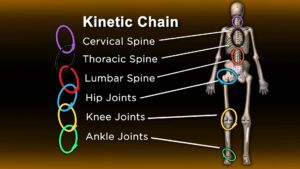 Achieving an elite pop time involves understanding the scientific principles underlying the mechanics of throwing. This includes the kinetic chain, the role of ground force, and the biomechanics of an efficient throw. Each of these elements contributes to the catcher’s ability to quickly and accurately throw out base runners.
Achieving an elite pop time involves understanding the scientific principles underlying the mechanics of throwing. This includes the kinetic chain, the role of ground force, and the biomechanics of an efficient throw. Each of these elements contributes to the catcher’s ability to quickly and accurately throw out base runners.
Kinetic Chain in Throwing: Sub 2.0 Catcher Pop Time
The kinetic chain refers to the sequence of movements that transfer energy from one part of the body to another. In throwing, this involves a coordinated effort starting from the legs and moving up through the hips, torso, shoulder, arm, and finally to the hand. The efficiency of this kinetic chain determines the speed and accuracy of the throw.
- Legs: The process begins with the legs generating force against the ground. This force travels up through the body, providing the initial power needed for the throw.
- Hips: The hips rotate to transfer the energy generated by the legs. Proper hip rotation is crucial for generating torque and maintaining balance.
- Torso: The torso follows the hip rotation, further amplifying the force. A strong core helps stabilize the body and directs the energy flow.
- Shoulder: The shoulder acts as a hinge, allowing the arm to move rapidly while maintaining control.
- Arm and Hand: The final stage involves the arm and hand, where the energy culminates in a quick, powerful release of the ball. The arm's speed and the hand's grip are critical for accuracy and velocity.
Efficient use of the kinetic chain ensures that each body segment contributes to the throw, maximizing power while minimizing the risk of injury.
Role of Ground Force in Pop Time: Sub 2.0 Catcher Pop Time
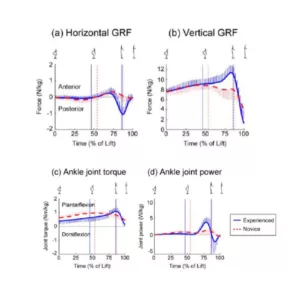 Ground force refers to the force exerted by the feet against the ground, which is then used to propel the body. In the context of pop time, ground force is essential for generating the necessary power for a quick throw.
Ground force refers to the force exerted by the feet against the ground, which is then used to propel the body. In the context of pop time, ground force is essential for generating the necessary power for a quick throw.
- Initial Stance: The catcher’s stance must be stable and balanced, allowing for an effective push-off. The legs should be flexed and ready to explode into action.
- Push-Off: As the catcher receives the pitch, they use their legs to push off the ground. This initial movement is critical for creating momentum.
- Transfer of Force: The force generated by the legs is transferred through the hips and torso, contributing to the overall power of the throw. Proper foot positioning and timing are crucial to ensure this transfer is efficient.
- Landing and Follow-Through: After the throw, the catcher’s landing and follow-through help absorb the remaining energy, reducing the strain on the arm and shoulder.
The effective use of ground force not only enhances the power of the throw but also contributes to the speed and efficiency of the transfer from catching to throwing.
Biomechanics of an Efficient Throw: Sub 2.0 Catcher Pop Time
 Biomechanics studies the mechanical aspects of living organisms, and in baseball, it focuses on how the body moves during a throw. Understanding and optimizing these movements can significantly improve a catcher’s pop time.
Biomechanics studies the mechanical aspects of living organisms, and in baseball, it focuses on how the body moves during a throw. Understanding and optimizing these movements can significantly improve a catcher’s pop time.
- Stance and Setup: The catcher’s initial position should be low and balanced, ready to transition quickly from receiving to throwing.
- Receiving the Ball: The catcher needs to receive the ball with soft hands, cushioning the impact to prepare for a quick transfer. The glove should be positioned to facilitate a smooth transition to the throwing hand.
- Transfer Mechanics: The transfer of the ball from the glove to the throwing hand must be quick and precise. This involves minimal wasted movement and efficient hand positioning.
- Footwork: Proper footwork is essential for maintaining balance and generating power. The catcher should pivot on the back foot and step towards the target with the front foot, aligning the body for an accurate throw.
- Throwing Motion: The throwing motion should be compact and direct. The arm path should be efficient, with the elbow leading and the wrist snapping at the release point.
- Follow-Through: A proper follow-through helps ensure the throw’s accuracy and power. It also reduces the risk of injury by allowing the body to decelerate gradually.
Each of these biomechanical elements must work in harmony to achieve an efficient and powerful throw. Small improvements in any area can lead to significant gains in overall performance.
2X Mechanics and 2X Sub 2.0 Drills for Improving Pop Time
 Improving pop time to achieve a sub 2.0 level requires a comprehensive understanding of the 2X Mechanics and diligent practice of the 2X Sub 2.0 Drills. These elements are essential for catchers aiming to develop elite-level skills in reducing the time it takes to throw out base stealers. The following sections provide an in-depth look at these mechanics and drills.
Improving pop time to achieve a sub 2.0 level requires a comprehensive understanding of the 2X Mechanics and diligent practice of the 2X Sub 2.0 Drills. These elements are essential for catchers aiming to develop elite-level skills in reducing the time it takes to throw out base stealers. The following sections provide an in-depth look at these mechanics and drills.
2X Mechanics
The 2X Mechanics system focuses on the kinetic chain, emphasizing power generation from the ground up. This system includes several critical components designed to enhance a catcher's ability to perform a quick and powerful throw.
- Squat Position:
- A solid foundation begins with the squat position. This position involves good posture with the hips low and the trunk as vertical as possible. Proper alignment and mobility are crucial for maintaining balance and generating power.
- Pop Up Shuffle Step:
- This movement is the first power phase where the catcher drives up from the squat position, shuffles their feet, and prepares to throw. Quick and efficient footwork here is vital for reducing pop time.
- Load Position:
- After the pop-up shuffle step, the catcher loads their weight onto the back leg, preparing to drive towards the target. Maintaining a low center of gravity and proper alignment of the force vector are key elements.
- 2X Separation:
- This refers to the separation between the hips and shoulders during the throw. Achieving maximum separation ensures efficient energy transfer from the lower body to the upper body, enhancing throwing velocity.
- Chest Thrust External Rotation:
- In this phase, the catcher’s chest thrusts forward to support the external rotation of the throwing arm, which is crucial for maximizing throwing velocity.
- Internal Rotation Pronation:
- Here, the arm uncoils, generating high speeds through internal rotation and pronation. This phase is critical for the final acceleration of the ball.
- 2X Stabilization:
- Stabilizing the front leg at the moment of front foot strike is essential. This prevents any loss of power and ensures that the energy is efficiently transferred up the kinetic chain.
2X Sub 2.0 Drills
 The 2X Sub 2.0 Drills are designed to develop the specific skills and physical attributes needed to improve pop time. These drills use overload and underload techniques to enhance the speed and power of the kinetic chain.
The 2X Sub 2.0 Drills are designed to develop the specific skills and physical attributes needed to improve pop time. These drills use overload and underload techniques to enhance the speed and power of the kinetic chain.
- Sled Pop Shuffles:
- Begin in the squat position with a weighted sled. Perform a pop-up and shuffle step while driving against the sled. This drill enhances lower body strength and power, crucial for a quick pop-up.
- Sled 2X Drives:
- Start with feet shoulder-width apart and the sled harnessed. Drive the back leg forward while maintaining a low center of gravity, focusing on hip rotation. This drill improves the drive leg’s power and the timing of hip rotation.
- Resistance Bands Pop Throws:
- Use a resistance band and simulate the receiving, pop-up, and throwing motions. This drill focuses on explosiveness and speed of movement while maintaining proper mechanics.
- Assistance Bands Pop Throws:
- Similar to the resistance bands drill but with assistance bands to aid in the movement. This helps improve the speed of the arm and hip rotation.
- Resistance Bands Pop Throws with Weighted Ball:
- Perform the pop throw drill using a weighted baseball (no more than 7oz). This drill focuses on enhancing arm strength and speed.
- Assistance Bands Pop Throws with Assistance Ball:
- Use a light baseball and assistance bands. This drill helps increase the speed of the arm movement and improves overall throwing mechanics.
Key Performance Goals
The 2X Sub 2.0 Program sets specific performance goals to help catchers improve their pop times:
- Power to Weight Ratio:
- Achieving a 1.5 power to weight ratio in power lifts such as the power clean is essential for developing the necessary strength and explosiveness.
- Lower Body Strength to Weight Ratio:
- Aiming for a 2.0 ratio in lower body strength ensures that the legs and core are strong enough to support quick, powerful movements.
- Upper Body Strength to Weight Ratio:
- A 1.7 ratio in upper body strength is crucial for handling the forces generated during the throw and maintaining proper mechanics.
By mastering the 2X Mechanics and diligently practicing the 2X Sub 2.0 Drills, catchers can significantly improve their pop times, achieving the elite sub 2.0 level. This combination of technique, strength, and speed is essential for excelling at the highest levels of baseball.
Purchase NOW!
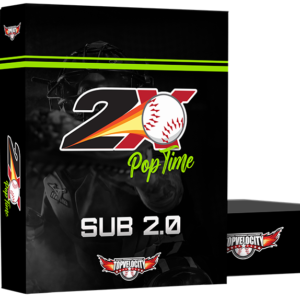 Unlock Your Full Potential Behind the Plate with the 2X Sub 2.0 Pop Time Program!
Unlock Your Full Potential Behind the Plate with the 2X Sub 2.0 Pop Time Program!
Are you ready to take your catching skills to the next level and achieve elite-level pop times? The 2X Sub 2.0 Pop Time Program by TopVelocity is designed to help you develop the speed, power, and precision needed to throw out base stealers with ease. This comprehensive training program combines advanced mechanics, strength conditioning, and targeted drills to ensure you reach your goal of a sub 2.0 pop time.
Don't miss out on the opportunity to transform your game. Visit TopVelocity.net/2x-velocity today and get started on the path to becoming the catcher every team needs. Join the ranks of elite athletes who have trusted TopVelocity to enhance their performance and dominate the diamond. Your journey to a quicker, more powerful pop time begins now!
Click here to purchase the 2X Sub 2.0 Pop Time Program: TopVelocity.net/2x-velocity
Invest in your future and become the catcher you were meant to be. Let's make those base stealers think twice before running on you!




